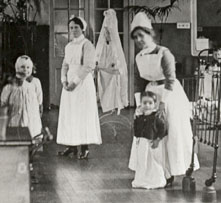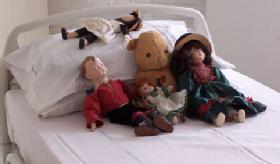Children in Hospitals
 ‘There’s nothing wrong with the lad’
‘There’s nothing wrong with the lad’
Before he collapsed with a sudden and excruciating pain in his left hip at the age of nine, Leonard Tasker had never before even visited a GP. His elder brother and brother-in-law wheeled him to Coventry and Warwickshire Hospital in a spinal carriage they had found. Unable to determine the source of Leonard’s excruciating pain, the doctor on duty declared, ‘There’s nothing wrong with the lad’. The boy’s brother, however, persisted, and so the doctor admitted Leonard for two days’ observation.
Following that day in 1925, Leonard Tasker spent nearly ten years of his childhood in hospitals. For two years doctors at Coventry and Warwickshire Hospital investigated the strange blur that appeared in the X-ray of his hip through exploratory surgery. He was suffering from tuberculosis of the hip, but orthopaedics was a new specialism then, and so a diagnosis was slow in coming.
Leonard’s treatment included being strapped to an iron frame that completely immobilised his hip. Despite what now seems like peculiarly harsh treatment for a young boy, he does not recall ever being bored. He occupied his time in learning shorthand and crafts, reading and writing stories. His ward had a veranda, so he could get fresh air and watch the comings and goings of hospital staff. The nurses also took care to keep Leonard and the other children on the ward occupied.
Visiting Hours
Between the 1920s and 1940s new ideas about childhood psychology influenced the hospital experiences of young people. No longer were children viewed simply as small adults, but rather as developing emotional and physical beings. To ensure they reached a healthy adulthood – and then in turn raised their own healthy children – it was important to minimise the impact of early traumatic experiences. Hospitalisation was one such experience.
 Before this period most hospitals enforced severely restrictive visiting hours. Physical contact was also discouraged – in some hospitals parents could only view their children through a glass window. Most children’s wards allowed visiting only once a month, some not at all. The obvious distress of hospitalised children was thought regrettable, but an inevitable consequence. With time, the child would grow accustomed to the new environment, and perhaps forget his or her parents altogether.
Before this period most hospitals enforced severely restrictive visiting hours. Physical contact was also discouraged – in some hospitals parents could only view their children through a glass window. Most children’s wards allowed visiting only once a month, some not at all. The obvious distress of hospitalised children was thought regrettable, but an inevitable consequence. With time, the child would grow accustomed to the new environment, and perhaps forget his or her parents altogether.
When the psychological condition known as separation anxiety was recognised in the late 1940s, particularly by the popular press, the treatment of children in hospitals – specifically the meagre visiting time allowed them – was deplored and reforms were urged. Nothing less than the emotional health of Britain’s children was at stake. With the wartime traumas of evacuation not forgotten, the interest in separation anxiety also had a patriotic aspect.
<- previous stage of exhibition | next stage of exhibition ->
Exhibition tour:
Children in Hospitals
